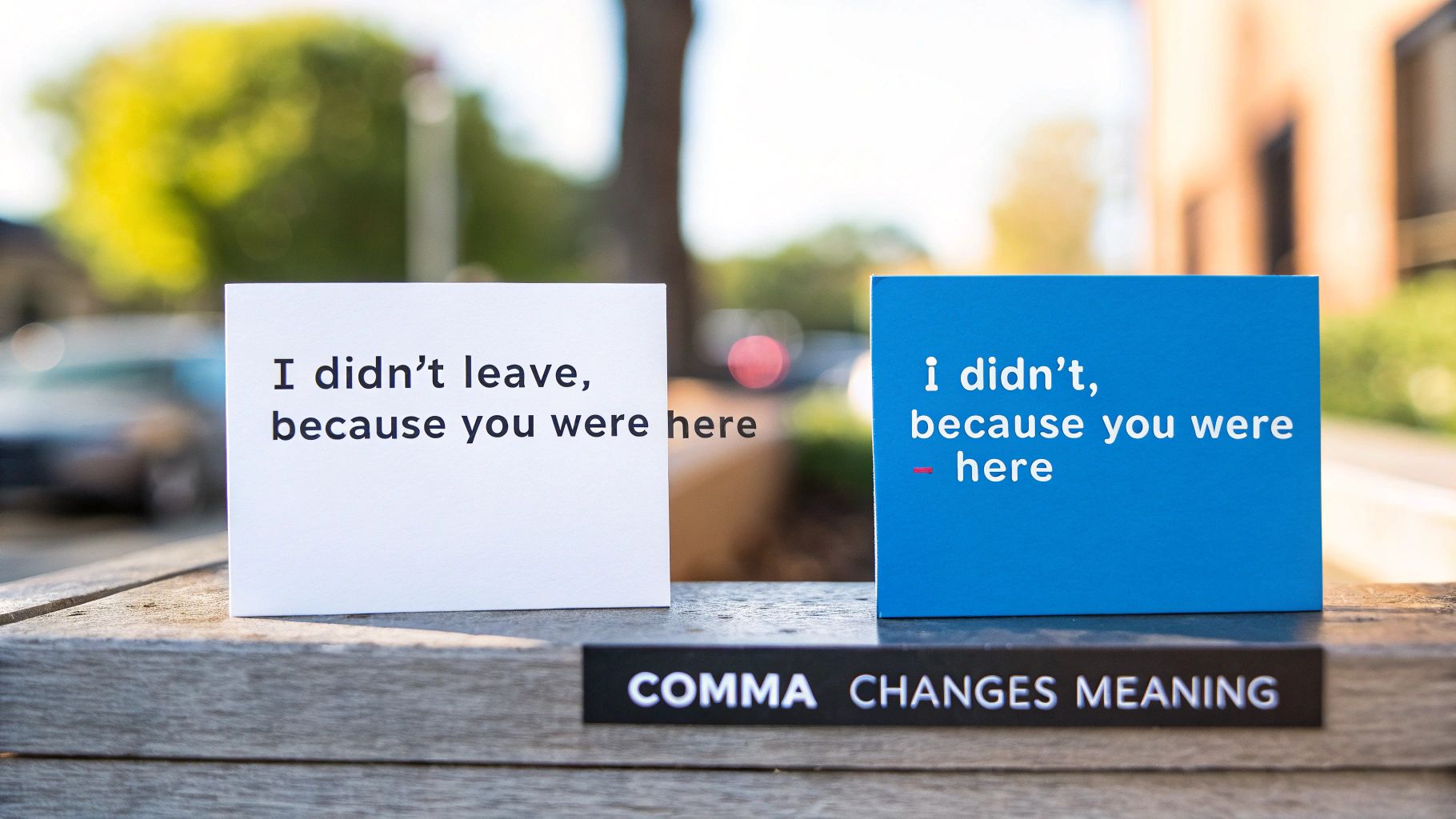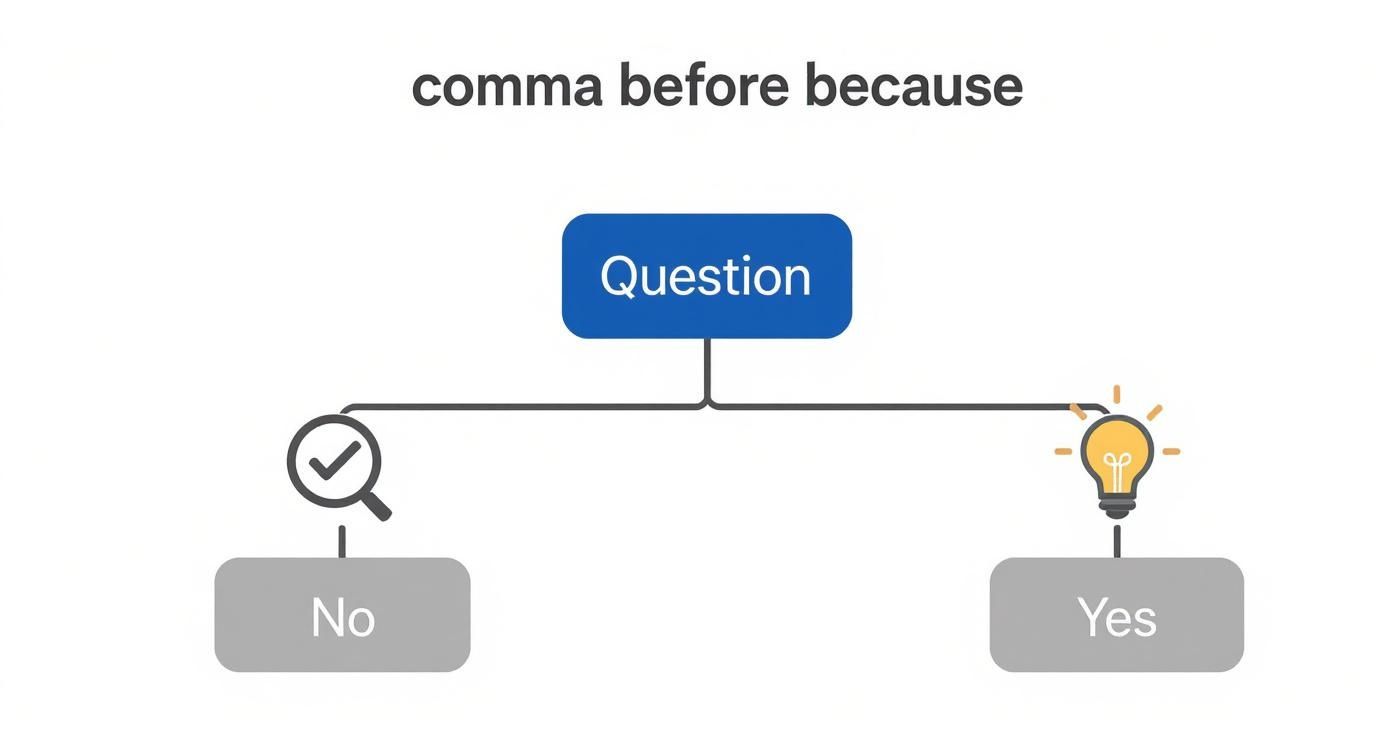Master the Comma Before Because Rule with Clear Examples

Most of the time, you do not need a comma before because. Simple as that. The comma is reserved for special cases, typically when the 'because' clause is tossing in extra detail that isn't critical to the sentence's main point. Think of it as the difference between a core reason and a side comment.
The Main Rule And Its Big Exception
The whole "comma before because" debate is one of the most common punctuation headaches writers run into. The confusion usually comes from a small misunderstanding of what 'because' is actually doing in the sentence. At its heart, it's there to introduce a reason.
The general rule is pretty straightforward: if the reason is essential to understanding the main point, leave the comma out. The 'because' clause is directly answering "why?" for the first part of the sentence. Without it, the meaning feels incomplete.
But here's the exception that trips people up. You do need a comma when the 'because' clause provides non-essential information. In these cases, the first part of the sentence works just fine on its own, and the reason is just an added thought. This is especially important in negative sentences, where a comma can clear up serious confusion.
Essential vs. Non-Essential Information
Getting the hang of essential versus non-essential clauses is the secret to nailing this rule every time. An essential (or restrictive) clause is vital; taking it away would change the sentence's entire meaning. A non-essential (or non-restrictive) clause is just extra commentary.
All the major style guides are on the same page here. For instance, The Chicago Manual of Style explains that a comma isn't used when the clause is fundamental to the meaning. It’s only added when the information is supplementary, which helps prevent misreading—especially with negative statements. You can dig deeper into their official guidance on the comma-before-because rule on their website.
This tiny piece of punctuation can completely flip a sentence's meaning. Take this example: "He didn't run because he was afraid." This could mean he did run, just not out of fear. Add a comma—"He didn't run, because he was afraid"—and it becomes crystal clear: fear was the reason he didn't run.
To make things easier, here's a quick reference table that breaks down the main scenarios.
Quick Guide: Comma vs. No Comma with 'Because'
| Situation | Comma Rule | Example |
|---|---|---|
| Essential Reason | No Comma | She stayed home because she felt sick. |
| Non-Essential Information | Use a Comma | He must be nearby, because his car is in the driveway. |
| Clarifying a Negative | Use a Comma | I didn't call you, because I lost my phone. |
Keep this table handy, and you'll find that making the right call becomes second nature over time.
Understanding The No-Comma Rule For Essential Clauses
Here’s the most common and straightforward rule for “because”: if the reason is essential to the sentence’s meaning, you don’t use a comma. This is the default setting for the great majority of sentences you'll write. Grammarians call this type of phrase a restrictive or essential clause.
Think of it like pointing to a specific car in a crowded parking lot. If you just say, "I like that car," your meaning is vague. But when you say, "I like that car because it's bright red," the "because" clause becomes essential. It narrows the meaning down to one specific car, making your statement perfectly clear. Without it, the core message is lost.
Identifying an Essential Clause
An essential clause directly answers the question "why?" for the main action in the sentence. If you remove it, the sentence either feels incomplete or its meaning changes entirely. The information isn't just an extra detail; it’s the foundation of the statement.
Here are a few clear examples where the "because" clause is absolutely necessary:
- She left the party early because she felt unwell. (Why did she leave early? Because she felt unwell. The reason is critical to understanding the situation.)
- The project succeeded because the team worked together. (Why did it succeed? Teamwork. This is the core reason, not a side note.)
- He watered the plants because they looked dry. (Why did he water them? Because they looked dry. This is the direct cause, not optional information.)
In each of these sentences, the "because" clause gives the central reason for the action. Adding a comma before "because" would create an awkward pause, incorrectly signaling that the reason is just a minor detail when it’s actually the main point.
Here's a simple test: Ask if the first part of the sentence can stand alone without losing its intended focus. "She left the party early" is a complete sentence, sure, but it's missing the why. The "because" clause completes the thought, making it essential.
Getting this concept down is a huge step toward improving your writing. For those looking to sharpen their grammar even more, exploring guides on how to improve English writing skills can offer some great techniques. Once you understand when not to use a comma, you've built a strong foundation for learning the exceptions, which we'll get into next.
Knowing When You Need a Comma For Extra Information
While the no-comma rule handles most cases, the biggest exception pops up when the "because" clause adds extra, non-essential information. You can think of these clauses like a side comment in a conversation—they offer some interesting context or a bonus fact, but they aren't critical for the main point to land.
Grammar experts call these non-restrictive clauses. The main part of the sentence can stand on its own just fine without them. The "because" clause is just there to offer an additional thought or justification that isn't essential to understanding the core action. It’s like you’ve already made your point, and now you're just adding a little extra detail.
A Simple Test For Non-Essential Clauses
Here’s a handy trick you can use to spot these clauses. If you can mentally wrap the "because" part of the sentence in parentheses and the sentence still makes perfect sense, you probably need a comma.
Let's test it out:
- He must have left for the day, because his office is dark.
Now, let's try the parentheses: "He must have left for the day (because his office is dark)." The main statement, "He must have left for the day," is a complete thought. The dark office is just the evidence we're using to explain our conclusion. It's extra information.
Here are a couple more examples:
- The ground is wet, because it rained overnight. (The main observation is that the ground is wet; the rain is simply the explanation.)
- She’s probably happy with the results, because she’s smiling. (The core idea is that she seems happy; her smile is the non-essential reason for our guess.)
Major Style Guides Agree on This Exception
This isn't just some quirky style preference; it's a key principle for clear writing backed by the major style guides. For instance, the MLA Handbook advises using a comma before 'because' when the clause introduces a nonessential reason. They also note that a comma can prevent misreading, especially in negative sentences where things can get ambiguous fast. You can get more details about this guidance from the MLA on their style blog.
Key Takeaway: A comma before "because" is a signal that the reason following it is an afterthought or an extra detail, not a core piece of the main statement. The main clause should be able to stand on its own as a full sentence.
Using the simple "parentheses test" is a reliable way to figure out if a comma before because is the right move. If you find yourself wrestling with sentences like these, a writing assistant can be a lifesaver. Tools like Word Spinner are great for rephrasing sentences to make sure they flow naturally and follow grammatical rules, helping you humanize content for a clearer, more professional tone.
How a Comma Completely Flips the Meaning in Negative Sentences
This is where things get really interesting—and where most of the confusion around this rule comes from. When you add a negative word like not, never, or no into the mix, that tiny comma doesn't just tweak the meaning. It can completely reverse it.
Get this wrong, and your reader could walk away with the exact opposite impression of what you wanted to say. When you write a negative statement followed by "because" without a comma, you're actually negating the reason, not the action. It's a subtle distinction that can completely derail your message.
Without a Comma: The Action Happened for a Different Reason
Let's break down the classic example that trips everyone up.
Example: I didn't leave the party because I saw you.
Read that sentence again. It’s a bit of a head-scratcher, isn't it? The most natural way to read this is that the speaker did leave the party, but not for the reason you might think. Seeing you wasn't the cause. Maybe the music was terrible, or they were just tired. The point is, they left, but for some other reason.
With a Comma: The Action Did Not Happen at All
Now, let’s pop a comma in there and see what happens.
Example: I didn't leave the party, because I saw you.
Night and day, right? The comma creates a hard stop, separating the main idea from the explanation. The main idea is simple: "I didn't leave the party." The "because" clause tells us why that action didn't happen. Seeing you was the reason the speaker stayed. The comma makes it perfectly clear that the negative applies to the action (leaving), not the reason.
The takeaway is simple: In a negative sentence, the comma acts as a spotlight. It tells the reader that the "because" clause explains why the main action did not happen. Without the comma, the "because" clause explains why the main action happened for a different reason.
This isn't just a niche grammar quirk; it’s a fundamental part of clear writing. Even major authorities like Purdue University's Online Writing Lab (OWL) stress that a comma is often essential for clarifying meaning in negative sentences. They point out that without the comma, the "because" clause gets bundled into the part of the sentence being negated.
You can dive deeper into their expert advice on how commas clarify meaning in complex sentences. Getting a handle on this one rule can save you from some of the most common and confusing grammatical blunders, making sure your message lands exactly as you intended.
Putting The Rule into Practice With Real Examples
Grammar rules can feel abstract, but the decision to use a comma before because is a practical choice professional writers make every day. Looking at examples from different fields shows how this tiny punctuation mark does some heavy lifting in the real world, making writing clearer and more precise.
In journalism, where clarity is everything, editors use this comma to shut down any chance of misinterpretation. You might see a sentence like, "The city council did not approve the budget, because key financial details were missing." That comma makes it crystal clear that the missing details were the direct cause for the disapproval. Without it, you could be left wondering if the budget was approved for some other reason.
How Often Does This Really Happen?
While leaving the comma out is far more common, adding one is a deliberate and well-established practice, especially in professional writing. This isn't some rare, quirky exception.
A detailed linguistic study of 44 million words from The Wall Street Journal found that a comma appeared before "because" in 13% of its uses. Researchers counted 6,354 instances of this construction—a number so high it couldn't possibly be a string of typos. This proves that in high-stakes professional journalism, adding a comma for clarity is a standard tool in a writer’s kit. You can dive deeper into the findings of this linguistic analysis to see the data for yourself.
Expert Insight: In business communications, a single misplaced comma can change the meaning of a contract or proposal. A sentence like, "We cannot proceed with the project because the funding is unconfirmed," is dangerously ambiguous. A comma clears it right up: "We cannot proceed with the project, because the funding is unconfirmed."
This principle extends to creative writing, too. In a novel, a character might think, "He didn't trust her, because she had lied before." The comma separates the action (the distrust) from the reason (the past lie), giving the sentence a more thoughtful, reflective rhythm. It slows the reader down just enough to let the weight of the cause sink in.
Ultimately, mastering the comma before because is less about memorizing a rigid rule and more about understanding its effect on your reader. If you’re ever unsure how to phrase a complex idea, our guide on how to ask ChatGPT to polish your writing can offer helpful strategies for refining your sentences.
Practical Tips For Everyday Writing
Knowing the rules is one thing, but actually using them in the heat of writing is another. To make the "comma before because" decision feel more like second nature, it helps to have a quick mental checklist.
Before you drop in that comma, just pause and ask yourself these three questions:
- Is this reason essential? If the "because" clause is the core explanation for the main action, and the sentence would feel incomplete or nonsensical without it, leave the comma out.
- Is this just extra info? If the main clause can stand on its own as a complete thought, and the reason feels more like a bonus detail or an aside, go ahead and add the comma.
- Is this a negative sentence? Pay close attention when you see the word "not." Adding a comma here is often critical to clarify that the reason explains why something didn't happen.
This decision-tree flowchart is a great way to visualize that thought process. It walks you right from the sentence you're writing to the correct punctuation.
As you can see, the most common path leads to no comma, which reinforces the idea that adding one is the exception, not the rule. It’s reserved for those non-essential, "by the way" kinds of clauses.
When in Doubt, Rewrite the Sentence
Let's be honest, sometimes a sentence is just awkward, especially with those tricky negative clauses. Instead of staring at it and agonizing over comma placement, the fastest and clearest solution is often just to rephrase it.
For instance, instead of getting tied up in "I didn't choose that option because it was too expensive," you could simply write, "It was too expensive, so I chose a different option." The ambiguity is gone.
Even the popular writing assistant Grammarly bases its suggestions on this same essential vs. non-essential logic. Their guidance confirms that a comma is typically used when the "because" clause is just supplementary information—a comment on the main idea. You can dive deeper into their take on the comma before because rule for more examples.
For writers who really want to sharpen their sentence structure, a dedicated tool can be a huge help. A leading rewriter like Word Spinner can help you untangle complex sentences, ensuring they’re not only grammatically correct but also flow naturally and steer clear of any AI detection flags. Building these skills is a core part of becoming a stronger writer, and you can find more strategies in our guide on how to improve your writing skills.
Common Questions About Commas And Because
Even after laying out the rules, some specific questions always seem to pop up. Let's tackle the most common ones to clear up any lingering confusion about putting a comma before because.
Does This Rule Change for Formal Writing?
Not really. The core principle stays the same whether you're writing a business report or a blog post: use a comma for non-essential info or to kill ambiguity.
In formal writing, like an academic paper, getting the comma right in negative sentences is crucial for precision. For casual writing, like a quick email, the main goal is just to be understood—but following the rule still helps get your point across cleanly.
What if a Sentence Starts with Because?
This is a totally different ballgame. When a sentence kicks off with a clause starting with "Because," you always need a comma right after it.
- Example: Because it was getting late, we decided to go home.
That comma is there to separate the opening reason from the main statement that follows. The rules we've been talking about in this guide are strictly for when "because" shows up in the middle of a sentence.
Is It Safer to Always Leave the Comma Out?
While it’s true that you don't need a comma most of the time, ditching it completely can lead to some serious mix-ups, especially with negative sentences. The sentence, "She didn't win the award because of her hard work," is a perfect example of a head-scratcher. Did she lose due to her hard work, or did she win for a different reason altogether?
A comma provides instant clarity: "She didn't win the award, because of her hard work." It’s much better to learn the exception than to risk being completely misunderstood. When you're on the fence, running your work through a grammar tool can be a huge help; for instance, some writers check their text against a Grammarly AI checker to catch these kinds of subtle errors and boost readability.
For writers looking to refine their sentences and ensure perfect grammar every time, Word Spinner offers advanced rewriting capabilities. It helps humanize content, removes AI detection, and guarantees 100% plagiarism-free output, making your writing clear and natural.



